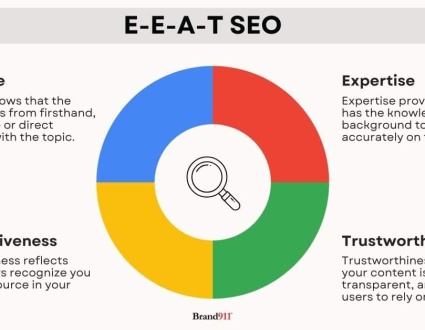
Your content might be good, but without video, it’s harder to rank, keep visitors engaged, and stand out in search results. Competitors using video are earning more clicks, longer visits, and better placement in Google’s rich results.
When optimized correctly, video boosts engagement, improves rankings, and expands your visibility — all important factors for reputation marketing and improving search visibility.
How Video Helps SEO
Video content is one of the most effective ways to improve your site’s search performance. When used strategically, it impacts multiple SEO signals that search engines use to rank content.
Improves rankings
Websites featuring video content are 53x more likely to rank on Google’s first page. Video keeps visitors engaged longer, which sends positive signals to search engines about the quality and relevance of your page.
Increases dwell time
Users spend on average 2.6x more time on pages with video than on those without. This extra time on site tells Google that people find your content valuable, which can indirectly help your rankings (a key part of SEO-friendly content).
Boosts click-through rate (CTR)
Video results on Google have a 41% higher CTR than plain text results. When your search result includes a video thumbnail, it draws more attention and increases the likelihood that users will click through to your site.
Reduces bounce rate
Pages with video content can see up to a 60% reduction in bounce rate compared to text-only pages. This means visitors are more likely to stay and explore, especially if the video quickly answers their question or solves their problem.
Earns more backlinks
Blog posts with video attract 3× as many backlinks as those without. High-quality, engaging videos make your content more shareable and link-worthy, building backlinks that boost your page authority and overall rankings.
Triggers rich results
About 62% of Google searches include video results, such as carousels or featured snippets. Adding video (and optimizing it with schema markup) increases your chances of appearing in these eye-catching SERP features, which can significantly improve visibility and clicks.

How to Optimize Videos for SEO (7 Tips)
Optimizing your videos ensures they’re not just engaging for viewers, but also visible to search engines. Here’s how to get it right:
Use the Right Format & Compression
MP4 is the preferred format for web video because it offers excellent quality with manageable file sizes. Keep load times fast by compressing files without sacrificing clarity — slow-loading videos can hurt both user experience and rankings.
Add Captions & Transcripts
Captions make your videos accessible to all viewers, including those watching without sound. Transcripts give search engines readable text to crawl, helping them understand your video’s content and potentially rank you for additional keywords mentioned in the dialogue.
Use Schema Markup (VideoObject)
Adding VideoObject schema markup tells Google key details about your video, such as the title, description, duration, and thumbnail. This increases your chances of appearing in rich results like video carousels or featured snippets.
Create a Video Sitemap
A dedicated video sitemap provides search engines with a clear map of all your video content, making it easier for them to discover, index, and display your videos in search results.
Mobile-Friendly Design
With most video consumption happening on mobile devices, your videos must load quickly and play smoothly on any screen size. Responsive players and adaptive streaming can help ensure a seamless experience.
Keyword-Rich Titles & Descriptions
Incorporate your target topic naturally in the video’s title and early in the description. This not only improves discoverability but also signals relevance to both search engines and viewers.
Custom Thumbnails
Your thumbnail is often the first thing people notice in search results. Use high-contrast colors, clear imagery, and readable text to make it stand out. Thumbnails with human faces can be especially effective at grabbing attention.
Hosting & Placement
Where and how you host your videos can impact both reach and SEO performance.
YouTube Hosting
YouTube offers massive reach as the world’s second-largest search engine, with billions of active users. It handles technical optimization automatically and can expose your videos to new audiences, helping increase blog traffic and expand reach.
Self-Hosting
Hosting videos on your own website keeps viewers in your branded environment. You maintain full control over the viewing experience, prevent distractions from competitor content, and own all the analytics data for deeper insights.
Hybrid Approach
For the best of both worlds, upload your video to YouTube and embed it on your site. This creates double ranking opportunities — your YouTube video can appear in platform searches, while your webpage can rank in Google for the same keywords.
Placement Tip
Place videos above the fold — meaning in the part of your webpage that’s immediately visible without scrolling. This ensures visitors see the video right away when they land on your page, increasing the chances they’ll click play. When users engage quickly, it boosts watch time, lowers bounce rates, and sends strong positive signals to search engines that your content is valuable.
How to Measure Video SEO Success
Tracking the right metrics will show you whether your video content is improving SEO performance. Focus on a small, meaningful set of KPIs:
Watch Time and Retention Rate
Measure how long viewers watch and what percentage of the video they complete. Higher retention signals engaging content that search engines may reward.
Page Dwell Time
Track how long visitors stay on the page after arriving. Longer dwell times often indicate the video is holding attention and satisfying search intent.
Bounce Rate
See the percentage of visitors who leave without interacting further. A lower bounce rate suggests your video is encouraging users to explore more of your site.
CTR from Search Results
Look at how often people click your listing when it appears in search. Video thumbnails can increase CTR, making this an important metric to watch.
Backlink Growth
Monitor the number of inbound links to your video pages. Engaging, valuable video content is more likely to earn natural backlinks from other sites.
Rich Snippet / Video Carousel Appearances
Track whether your videos are showing up in Google’s rich results or video carousels. These placements increase visibility and can drive significantly more clicks.
Conclusion
Video can be a powerful driver of SEO, but only if it’s planned, optimized, and tracked correctly. When done right, it improves rankings, increases engagement, and expands your visibility in search results.
Key takeaways:
- Video keeps visitors on your site longer, boosts CTR, and lowers bounce rates — all positive SEO signals.
- Proper optimization (format, schema, captions, mobile-friendly design) ensures search engines can find and index your content.
- Smart hosting and placement strategies maximize both reach and on-site engagement.
Ready to make video a real SEO asset? Our SEO services include complete video SEO implementation, from technical setup to content optimization, so you can see measurable results in rankings and traffic.
About us and this blog
We are a digital marketing company with a focus on helping our customers achieve great results across several key areas.
Request a free quote
We offer professional SEO services that help websites increase their organic search score drastically in order to compete for the highest rankings even when it comes to highly competitive keywords.
Subscribe to our newsletter!
More from our blog
See all postsRecent Posts
- How to Distribute a Press Release (Without Wasting Time or Money) December 23, 2025
- What Is SEO Content? A Comprehensive Guide December 18, 2025
- How to Rebrand Yourself: A Practical 5-Step Plan for Professionals December 16, 2025













Recent Comments